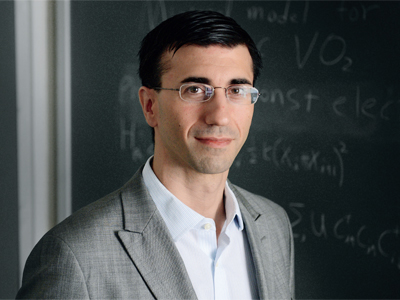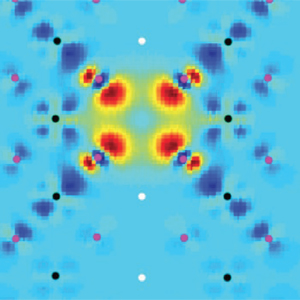Chris Marianetti: Theory Unlocks the Secrets at the Nanoscale
Theory Unlocks the Secrets at the Nanoscale

Chris Marianetti
(Photo by Eileen Barroso)
The first-principles theory of materials science continues a great tradition that emerged in the aftermath of the quantum revolution nearly 90 years ago. In 1929, Nobel Laureate Paul Dirac keenly noted, in essence, that the mathematical laws of physics necessary to describe all of materials science were completely known, but the solution of these equations was impossibly difficult.
Applying physics and mathematics to solve difficult equations is what brought electronics to our landscape. Much of today’s commonly used technology was developed based on preliminary understanding of how electrons move through various materials under different conditions. That theoretical science combined with heroic experimental efforts made it possible, by the mid-20th century, to harness the behavior of electrons in materials to create the modern computer.
In the realm of nanotechnology, theorists like Chris Marianetti, associate professor of materials science and applied physics and applied mathematics, are particularly important in helping understand how the subatomic world works in complex scenarios. To better understand and explain what happens on the nanoscale, theorists use quantum mechanics, the mathematical description of the motion and interaction of subatomic particles. The core equation in quantum mechanics is the Schrödinger equation.
“In terms of materials science and chemistry, the Schrödinger equation holds all the information that we need, but the secrets are locked away inside. We work to apply sophisticated mathematical formalisms, which are amenable to reasonable approximations, and work to develop new approaches when our existing methodologies break down,” explains Marianetti.

Research image provided by Chris Marianetti
It is these computational approaches that allow researchers to model outcomes of experiments with atomic particles—a job that would be prohibitive if one solely relied on experimental trial and error. These mathematical descriptions help researchers understand how to control the structure of matter and evaluate hundreds of possible material combinations to find the most promising.
“We can now predict many aspects of materials properties for systems spanning the entire periodic table,” says Marianetti.
One such material is graphene—a single layer of bonded carbon atoms one million times thinner than paper, which could replace silicon. Marianetti and his group used quantum mechanics to demonstrate that straining this material should induce a novel phase transition, which would cause graphene to mechanically break. Strain is a way to engineer the properties of graphene, so understanding its limits is very practical.
“This phase transition has not yet been observed, so it is still a bit of a mystery. Several colleagues not connected to our original work have proposed hypotheses on the absence of this transition, and five years out we are still searching for what we believe is the dominant reason. We believe we are close to unraveling this mystery, and ultimately experiment will prove us right or wrong; that is part of what makes this game so fun. I like to say that physics is an art, with a sense of right and wrong.”
Marianetti’s research has also enhanced understanding about the solid-state properties of plutonium, the radioactive element which is used in radioisotope thermoelectric generators, fuels in some types of nuclear reactors, and was used in creating many existing weapons in the world’s nuclear stockpile. He was the first to predict the temperature dependence of the magnetic properties of the material, which is relevant to safe storage of weapons and ensuring the Nuclear Test Ban Treaty far into the future. Research underway in his lab also focuses on understanding the behavior of nonconventional material and nanostructures of multifunction oxides, metals, and semiconductors to accelerate innovations in analog, logic, and memory devices.
Theory, as exploratory engineering, bookends the science of nanotechnology. Theorists help other scientists and engineers predict new possible combinations of atoms and molecules and, once combinations have been made, test those new materials to explain what is happening on the nanoscale. Theory magnifies experimental capability, and researchers like Marianetti are learning to create functional materials and devices via assembly and manipulation at the nanoscale.
“Theoretical and computational developments help us understand how materials behave under all sorts of conditions,” he says. “This understanding will enable us to design new materials at the atomic scale and work with experimentalists to realize novel phenomena and functionality.”
